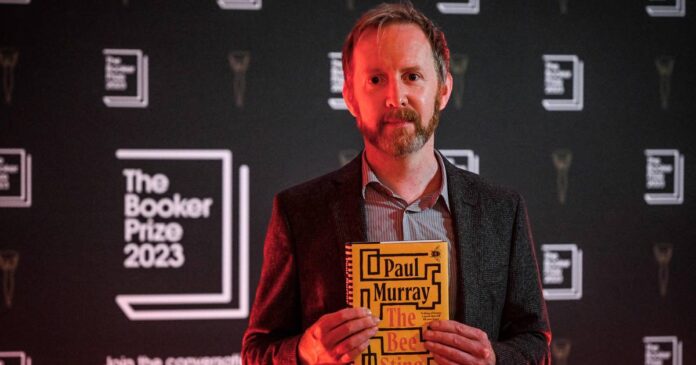In a column just before Labor Day, I mapped out my plan for staying on top of the deluge of desirable fall fiction releases, including books by Zadie Smith, Ben Fountain, Nathan Hill, James McBride and Teju Cole.
It was ambitious but doable, a little more than a book a week, not an unheard-of pace for a guy who gets to say that reading books is a significant part of his job.
Reader, I failed. Of the books by the authors in that list, the only one I’ve finished is McBride’s “The Heaven and Earth Grocery Store.” (It is terrific, by the way.)
No, instead of gorging on this veritable feast of anticipated books by favorite authors, I’ve been reading one book for over two weeks and the experience has been a good reminder that it’s OK to slow down and savor, that less can be more.
The book is “The Bee Sting” by Paul Murray, who is also the author of probably my favorite coming-of-age novel of all time, “Skippy Dies.” You don’t see Murray’s name in that list above because for some reason, I did not know the book was coming out. I do not know how this is possible. It’s akin to the middle-aged males of New Jersey not being aware that Bruce Springsteen is on tour.
“The Bee Sting,” like “Skippy Dies,” is a bit of a doozy, lengthwise, nearly 650 pages. It is the story of the Barnes family in a smallish Irish town, mother Imelda, father Dickie, kids Cass and PJ. The title refers to an incident at the wedding of Imelda and Dickie, which left Imelda with a great welt on her face, forcing her to wear her veil down for the entire ceremony and reception.
Things are rough in the present too. Dickie has squandered the car dealership his father started. High school senior Cass is trying to figure out what kind of place there is in the world for a young woman like her. Younger brother PJ is dodging threats from an older bully nicknamed “Ears” who says Dickie swindled his mother.
:quality(70)/cloudfront-us-east-1.images.arcpublishing.com/tronc/I7E77O2GGHJVML2CNQ4DZYHTRQ.jpg)
Murray is magical in his ability to create intimacy between reader and character. His use of close third-person narration and stream-of-consciousness tied to individual characters has us living vicariously through each family member.
To appreciate what this novel is doing and how it works best, you have to read every word, which sounds strange, but I know I’m not the only reader who may skim a bit to move things along from time to time. I was sitting down for my usual scheduled reading time and greatly enjoying the book, but also, was clearly not making what would be my usual progress toward the end.
About a third of the way through the book, we arrive at a section from Imelda’s point of view, set on a day where if things go right, the family’s fortunes may improve. It’s rendered in a sad and frantic stream-of-consciousness style moving back and forth through time, and I found myself going even slower. Thinking of the pile of books waiting for me, I started to panic.
I paged ahead. Imelda’s section was over 200 pages, almost a novel in itself. How would I be able to get to these books I want to talk about in my column, I wondered?
Taking a deep breath, I returned to the page, reminding myself that what I’m after when I read most of all is deep absorption and connection with the sensibility of others. I had everything I needed in my hands.
John Warner is the author of “Why They Can’t Write: Killing the Five-Paragraph Essay and Other Necessities.”
Book recommendations from the Biblioracle
John Warner tells you what to read based on the last five books you’ve read.
1. “Lessons in Chemistry” by Bonnie Garmus
2. “Dear Edward” by Ann Napolitano
3. “Wish You Were Here” by Jodi Picoult
4. “The Goldfinch” by Donna Tartt
5. “Daisy Jones & The Six” by Taylor Jenkins Reid
— Jemma P., Glenview
For Jemma, I’m recommending a writer who shares some concerns with the above titles in their explorations of American culture, but is also a bit spikier in her approach, lacing satire into the mix. The choice is “My New American Life” by Francine Prose.
1. “The Boys in the Boat: Nine Americans and Their Epic Quest for Gold at the 1936 Berlin Olympics” Daniel James Brown
2. “Harvey Penick’s Little Red Book: Lessons and Teachings from a Lifetime in Golf” by Harvey Penick
3. “Backlash” by Brad Thor
4. “No Sunscreen for the Dead” by Tim Dorsey
5. “Squeeze Me” by Carl Hiaasen
— Nick T., Chicago
No shade to Nick, but this looks like the books on a store display titled “for the man in your life.” I’d like to shake things up a bit while still giving Nick a reading experience he’ll enjoy. That brings me to the manly, but sensitive work of one of my favorites, Tom Drury, and his novel “The End of Vandalism.”
1. “Man’s Search for Meaning” by Viktor Frankl
2. “My Name is Asher Lev” by Chaim Potok
3. “Being There” by Jerzy Kosiński
4. “The Magic Christian” by Terry Southern
5. “Portnoy’s Complaint” by Philip Roth
— Benjamin N., Wilmette
Now, if this isn’t an interesting list. How about a dark and funny memoir about one man’s search for meaning in his struggles with his faith and community? “Foreskin’s Lament” by Shalom Auslander.
Get a reading from the Biblioracle
Send a list of the last five books you’ve read and your hometown to [email protected]



